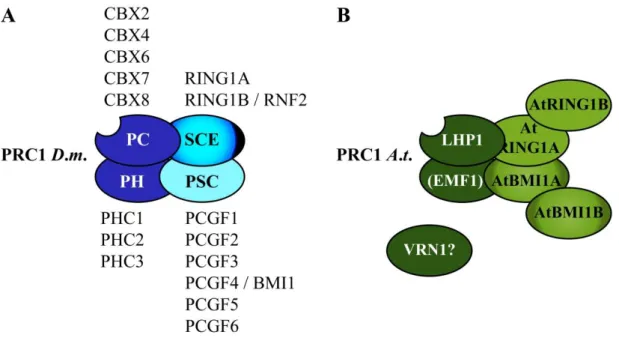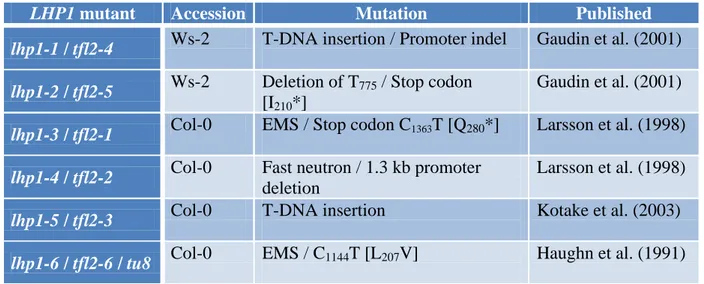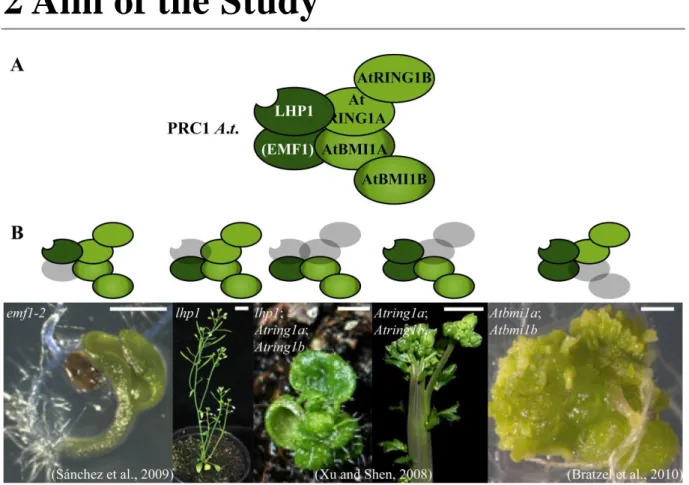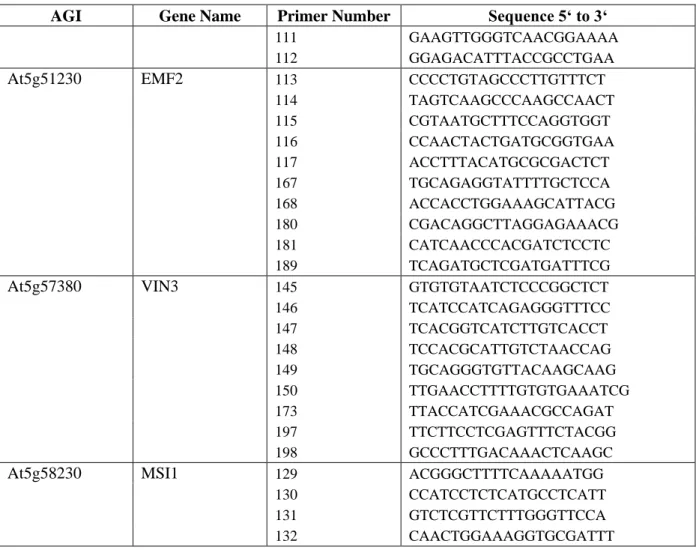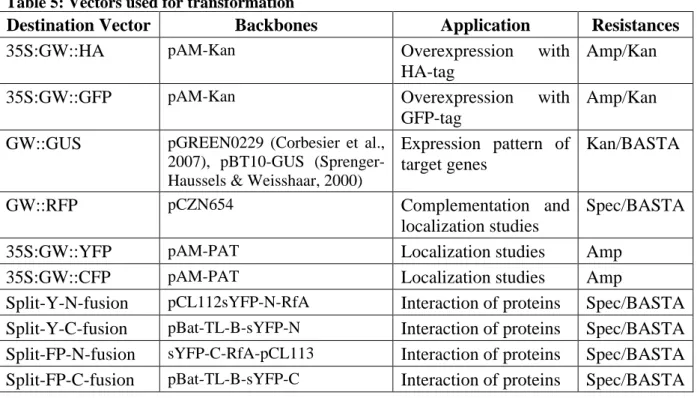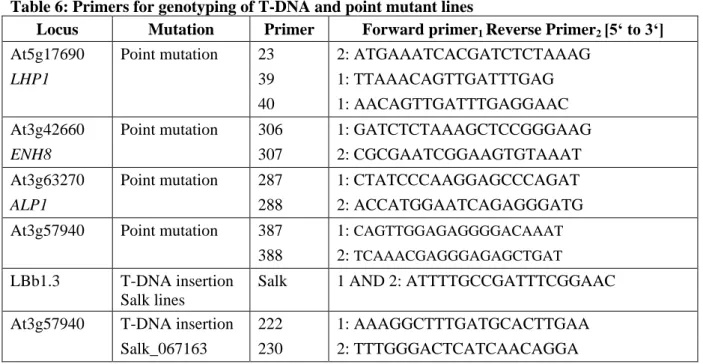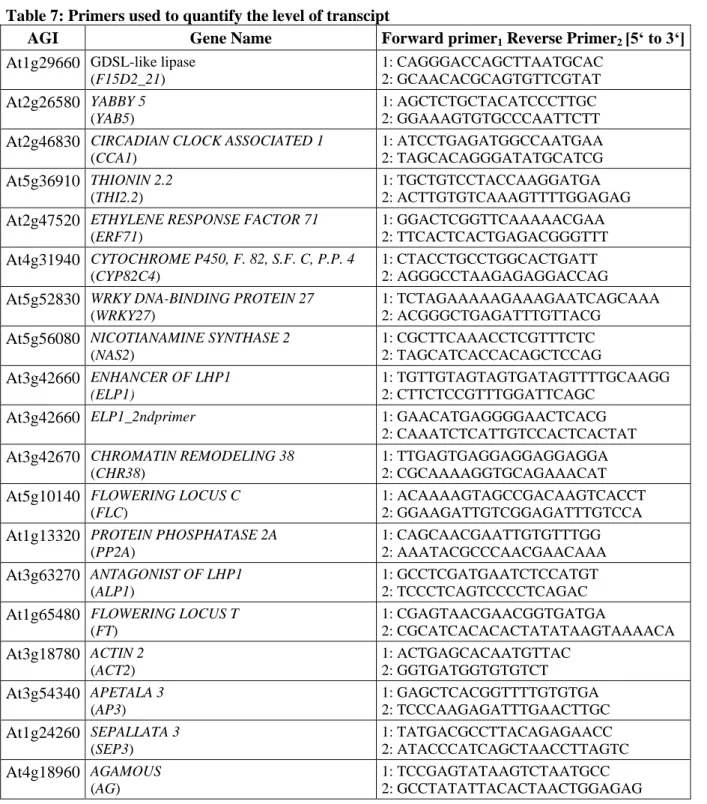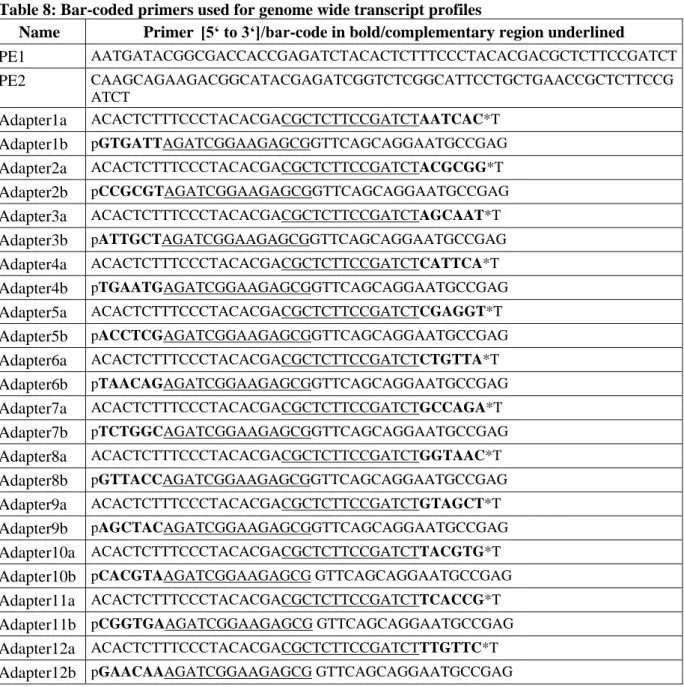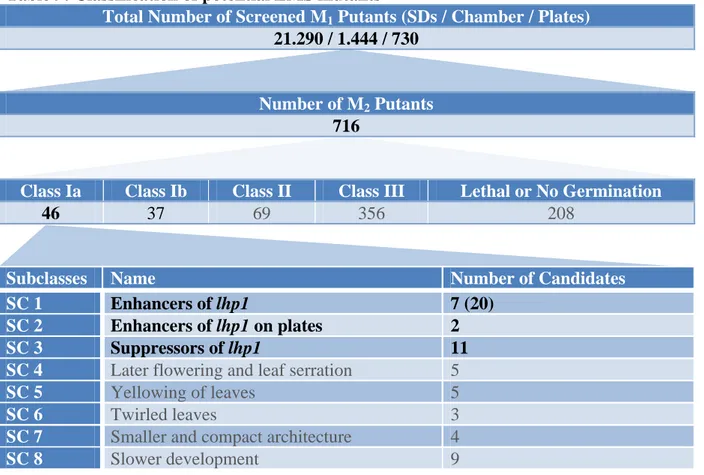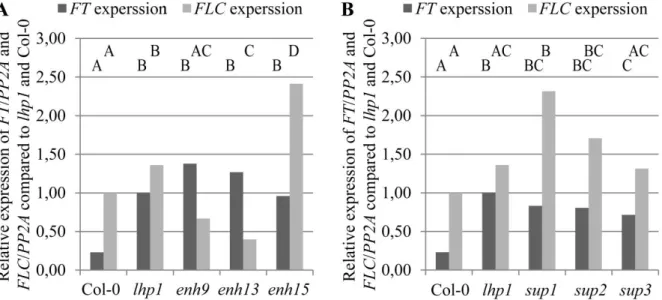ALP1 and ELP1 – novel genetic modifiers of LIKE HETEROCHROMATIN PROTEIN 1 participate in Polycomb mediated gene repression
in Arabidopsis
Inaugural-Dissertation Zur
Erlangung des Doktorgrades
der Mathematisch-Naturwissenschaftlichen Fakultät der Universität zu Köln
vorgelegt von
Benjamin Hartwig
aus Winsen/Luhe
ii
Entwicklungsbiologie der Pflanzen (Direktor: Prof. Dr. G.
Coupland) angefertigt.
Prüfungsvorsitzender: Prof. Dr. Martin Hülskamp
Berichterstatter: Prof. Dr. George Coupland Prof. Dr. Ute Höcker
Prüfungsdatum: 16.04.2012
iv
I
Abstract
Polycomb Group (PcG) proteins are involved in the inheritance of phenotypic traits by repressing the expression of target genes through binding of chromatin. In Arabidopsis thaliana several Polycomb Repressive Complexes (PRCs) are active during different stages of development. Distinct components of PRCs2, such as CURLY LEAF, SWINGER and MEDEA, contain a SET-domain for the trimethylation of lysine 27 at histone 3.
This trimethylationmark is bound by PRC1 which leads to stable repression of the corresponding euchromatic locus. LIKE HETEROCHROMATIN PROTEIN 1 (LHP1) is a plant PRC1 component and an orthologue of HETEROCHROMATIN PROTEIN 1 (HP1) of humans, flies and yeast. Two of the PcG proteins that bind LHP1 catalyze mono- ubiquitylation of histone 2A but do not display homology to PRC1 PcG proteins in other organisms. The aim of this study is the identification of enhancers and suppressors of the lhp1 mutant phenotype to unravel PRC1 characteristics and functions in plants.
Double mutants were generated with lhp1 seeds in the Col-0 background through application of EMS and selected by phenotype and quantitative real-time PCR of known PRC1 target genes. Next-generation-sequencing of backcrossed, isogenic, bulked DNA samples of candidates was conducted. This isogenic mapping-by-sequencing approach revealed causal amino acid changes for two suppressors and three enhancers of LHP1. One enhancer candidate encodes a WD 40 domain protein predicted to function as an interaction hub preferentially for nuclear proteins. A suppressor gene product has similarities to Harbinger transposases and likely contains a functional DNA-binding domain.
De-regulated genes in those double mutants were analyzed via mRNA-seq, to link candidate genes to a possible function in chromatin regulation. In the suppressor the majority of de- regulated genes in lhp1 were again expressed at wild-type (WT) levels. Some genes in the enhancer were de-regulated to a greater extend, than in lhp1. MADS-box transcription factors were up-regulated in lhp1 compared to WT. The up-regulation of those genes was moderated in the suppressor and higher in the enhancer. Consequently the suppressor and the enhancer were named ANTAGONIST OF LHP1 1 (ALP1) and ENHANCER OF LHP1 1 (ELP1) respectively. ALP1 and ELP1 are nuclear proteins that both interacted with LHP1 in split- YFP assays. Further, ELP1 interacted with INCURVATA 2 (ICU2), a subunit of DNA- polymerase alpha that is binding LHP1 in vitro.
ALP1 and ELP1 present a possible link to epigenetic regulation. ALP1 could be a direct repressor of LHP1, while ELP1 might be part of PRC1.
II
III
Zusammenfassung
Polycomb Group (PcGs) Proteine nehmen auf die Vererbung phänotypischer Merkmale Einfluss, indem sie Chromatin binden und somit Zielgene reprimieren. In Arabidopsis thaliana sind mehrere Polycomb Repressive Komplexe (PRCs) in unterschiedlichen Entwicklungsphasen aktiv. Einzelne Komponenten von PRCs2, wie CURLY LEAF, SWINGER und MEDEA, beinhalten eine SET-Domäne, mittels derer sie Lysin 27 von Histon 3 tri-methylieren.
Diese Histonmarkierung wird von PRC1 gebunden, wodurch entsprechende, euchromatische Loci stabil reprimiert werden. LIKE HETEROCHROMATIN PROTEIN 1 (LHP1) ist Teil von PRC1 in Pflanzen und ein Ortholog von HETEROCHROMATIN PROTEIN 1 (HP1) aus Menschen, Fliegen und Hefe. Zwei LHP1 bindende PcG Proteine katalysieren die Monoubiquitinierung von Histon 2A, zeigen jedoch keine Homologie zu PRC1 PcG Proteinen anderer Organismen. Das Ziel dieser Studie war die Indentifizierung von Verstärkern (Enhancer) und Unterdrückern (Suppressoren) des lhp1 Mutantenphänotyps, um die Charakteristika und Funtionen von PRC1 in Pflanzen zu entschlüsseln.
Doppelmutanten wurden mit lhp1 Samen im Col-0 Hintergrund durch die Anwendung von EMS generiert und phänotypisch, sowie durch quantitative Echtzeit-PCR bekannter PRC1 Zielgene selektiert. Isogene Mischproben der DNA von Kandidaten des Screens wurden mit Sequenziern der neuen Generation sequenziert. Diese isogene Katrierung durch Sequenzierungsanwendung enthüllte kausale Aminosäureänderungen für zwei Suppressoren und drei Enhancer von LHP1. Ein Enhancerkandidat kodiert für ein Protein mit einer WD 40 Domäne, welches als ein Protein mit vielen Interaktionen, preferentiell mit nuklearen Proteinen, prognostiziert wird. Ein Genprodukt eines Suppressors zeigt Ähnlichkeiten zu Harbinger Transposasen und enthält wohlmöglich eine funktionelle DNA-Bindedomäne.
Deregulierte Gene in diesen beiden Doppelmutanten wurden durch mRNA-Sequenzierung analysiert, um die Zielgene mit einer möglichen Funktion in der Regulation von Chromatin zu verbinden. Im Suppressor waren die Mehrheit der in lhp1 de-regulierten Gene wieder auf Wildtyp (WT) Niveau exprimiert. Einige Gene des Enhancers waren in höherem Maße de- reguliert als in lhp1. MADS-box Transkriptionsfaktoren in lhp1 waren hochreguliert im Vergleich zum WT. Die Hochregulation dieser Gene war abgeschwächt im Suppressor und erhöht im Enhancer. Aus diesem Grund wurden der Suppressor ANTAGONIST OF LHP1 1 (ALP1) und der Enhancer ENHANCER OF LHP1 1 (ELP1) genannt. ALP1 und ELP1 sind nukleare Proteine, die beide mit LHP1 in gespaltenem YFP Untersuchungen interagierten.
IV
Weiterhin interagierte ELP1 mit INCURVATA 2 (ICU2), einer Untereinheit der DNA Polymerase Alpha, welche LHP1 in vitro bindet.
ALP1 und ELP1 zeigen eine mögliche Verbindung zu epigenetischer Regulation. ALP1 könnte als direkter Repressor von LHP1 fungieren, während ELP1 eventuell Teil eines PRC1 ist.
V
Table of Contents
1.1 Chromatin and transcription ... 1
1.2 Polycomb repressive complexes in different organisms ... 2
1.2.1 Composition and function of PRC1 ... 3
1.2.2 Composition and function of PRC2 ... 5
1.2.3 Targeting of specific DNA sequences by PRCs ... 6
1.2.4 Influence of histone modifications on transcription ... 7
1.2.5 Propagation of the chromatin state through DNA replication ... 8
1.3 LHP1 isolation, function and binding partners ... 9
1.3.1 Isolated LHP1 mutant lines and their phenotypes ... 9
1.3.2 Impact on flowering time ... 11
1.3.3 Protein structure and function of LHP1 ... 12
1.4 Mapping-by-sequencing ... 13
3.1 Plant material ... 19
3.1.1 Plant growth conditions ... 19
3.1.2 Flowering time measurements and phenotyping of plants ... 19
3.2 EMS treatment of seeds ... 20
3.3 Selection of potential mutants (putants) ... 20
3.3.1 Selection of enhancers and suppressors of lhp1 ... 21
3.3.2 Sanger sequencing to select enhancer candidates ... 21
3.4 Classical mapping of EMS induced SNPs ... 23
3.5 Next-generation mapping ... 24
3.6 Plasmid construction ... 25
3.6.1 Transgenic plants ... 27
3.7 Genotyping of T-DNA insertion lines and EMS mutant lines ... 27
3.8 DNA extraction ... 29
3.9 Quantification of transcription ... 30
Abstract I
Zusammenfassung III
Table of Contents V
1 Introduction 1
2 Aim of the Study 17
3 Material and Methods 19
VI
3.10 mRNA-Seq ... 32
3.11 Western Blotting ... 33
3.12 Co-infiltration of tobacco leaves for split-YFP detection ... 34
3.13 Acceptor Photo Bleaching (APB) ... 34
3.14 Neighbor Joining analysis ... 35
3.15 Buffers, Solutions and Medium ... 35
4.1 Classification of EMS mutants ... 39
4.1.1 Altered conditions improved screening for aberrant phenotypes ... 40
4.1.2 Division of Class I into Class Ia and Class Ib ... 41
4.1.3 Sorting putants into subclasses ... 41
4.1.3.1 Enhancers of lhp1 ... 43
4.1.3.2 Suppressors of lhp1 ... 44
4.2 Analysis of enhancers and suppressors of lhp1 ... 46
4.2.1 Expression analysis of enhancers and suppressors ... 46
4.2.2 Description of sup3 and enh9 phenotypes ... 47
4.2.3 Comparative global gene expression analysis of sup3, enh9, lhp1 and WT ... 49
4.2.4 Confirmation of mRNA-seq results... 52
4.2.5 H3K27me3 decoration of de-regulated genes ... 54
4.2.6 Active and repressive marks do not change globally ... 55
4.3 Isogenic mapping of causal mutations by bulked re-sequencing ... 56
4.3.1 Validation of the SNP underlying the alp1 phenotype ... 59
4.3.2 Phylogenetic analysis of ALP1 ... 61
4.3.3 Validation of the SNP underlying the elp1 phenotype ... 63
4.3.4 Single mutant analysis ... 64
4.3.5 ALP1 and ELP1 expression are not influenced by LHP1 ... 65
4.3.6 Analysis of de-regulated MADS domain transcription factors ... 67
4.4 Nuclear localization and binding studies ... 68
4.4.1 ELP1 is a nuclear protein ... 68
4.4.2 ALP1 and ELP1 interact with LHP1 in tobacco leaf cells ... 69
4.4.3 YFP-ALP1 does not co-localize with CFP-LHP1 in tobacco nuclei ... 71
5.1 Selection of Enhancers and Suppressors of lhp1 ... 73
5.1.1 Enhancers of lhp1 fall into four categories ... 73
4 Results 39
5 Discussion 73
VII
5.1.2 Flowering time of selected enhancers and FT regulation ... 75
5.1.3 Effect of ambient temperature changes ... 76
5.2 Isogenic bulked mapping-by-sequencing ... 76
5.2.1 Advantages of isogenic mapping-by-sequencing over conventional approaches ... 76
5.2.2 Enhancers of LHP1 reveal a relation to telomere regulation ... 78
5.3 ALP1 and ELP1 – two sides of LHP1 ... 79
5.3.1 ALP1 is a domesticated transposase-like gene ... 79
5.3.2 Localization and binding properties of ALP1 ... 81
5.3.3 ALP1 does not alter selected histone marks globally ... 81
5.3.4 A dual function of ALP1 in gene activation ... 82
5.3.5 ELP1 is neither regulated by LHP1 nor by its neighboring gene ... 84
5.3.6 ELP1 is an interaction hub binding LHP1 in the nucleus ... 85
5.3.7 Interaction with ICU2 and influence on chromatin remodeling ... 86
7.1 Supplemental Figures ... 103
7.2 Supplemental Table ... 106
7.3 Abbreviations ... 109
7.3.1 General abbreviations ... 109
7.3.2 Gene and protein names ... 112
6 Conclusions and Perspectives 87
6 Bibliography 89
7 Appendix 103
Acknowledgements 114
Erklärung 116
Lebenslauf 118
VIII
1
1 Introduction
1.1 Chromatin and transcription
Plants can adapt their developmental programs according to internal and external stimuli they perceive. Different layers of epigenetic memory enable them to mold a stimulus into a developmental or responsive program without changing the DNA code. Those layers are methylation of DNA, exchange of histone variants, modification of histone tails and the positioning and higher-order structure of nucleosomes and DNA (Berger, 2007). Evidence accumulates that a mixture of all layers is responsible for the success of an adapted developmental program that can be inherited through multiple cell cycles (Ahmad et al., 2010;
Beisel and Paro, 2011; Roudier et al., 2009).
In eukaryotes DNA is usually densely packed in the nuclei of cells. Packaging of DNA into higher-order is achieved by nucleosomes, which consist of 147 base pairs (bp) of DNA wrapped around histone octamers in a 1,65 super-helical turn (Luger et al., 1997). Histone core complexes are composed of four heterodimers of histone 2A and 2B (H2A and H2B), as well as histone 3 (H3) and histone 4 (H4). Histone 1 (H1) facilitates higher-order packaging by linking nucleosomes and DNA which results in tightly packed nucleosomal structures.
Nucleosomes, DNA-binding factors, the basal transcription machinery and its emerging transcripts, DNA-repair and replication machineries as well as proteins interacting with all of those factors are referred to as chromatin (van Steensel, 2011).
Chromatin is viewed as a highly dynamic structure that affects numerous DNA transactions, such as transcription, replication, repair, recombination and transposition, as well as chromosome segregation (Margueron and Reinberg, 2010; Roudier et al., 2009; Simon and Kingston, 2009). The tails of histones are exposed and can be post-translationally modified, even when they are incorporated into nucleosomes. Modifications are particularly abundant on N-terminal tails of H3 and H4 and are highly conserved across kingdoms. Lysine residues can be modified by acetylation, methylation, ubiquitinylation or sumoylation. Arginine residues are only associated with symmetric or asymmetric methylation. Serine and threonine residues are prone to be phosphorylated (Bedford and Clarke, 2009; Kouzarides, 2007).
Depending on the modified amino acid residue, methylation of histones can either be associated with activation or repression of transcription (Berger, 2007). Complexes binding histone marks associated with repression can aid in presenting a chromatin barrier for RNA
2
Polymerase II (Pol II). Complexes binding marks associated with activation facilitate transcriptional elongation and likely contain an anti-silencing function by relieving promoters of repressive marks (King et al., 2002; reviewed in Schuettengruber et al., 2011).
In plants, chromatin dynamics have been most extensively studied in Arabidopsis thaliana (Arabidopsis). This model organism has a genome size of 125 mega bases (Mb), containing about 28,000 genes (Kaul et al., 2000). Most of those genes are localized within euchromatin (~100 Mb), which is a gene-rich and less condensed form of chromatin. In contrast, heterochromatin is relatively gene-poor, stays highly condensed throughout most of the cell cycle and contains the highest number of transposable elements and other repetitive regions in Arabidopsis (Beisel and Paro, 2011; Grewal and Elgin, 2007). Epigenetic silencing of heterochromatic loci is generally associated with high levels of DNA methylation that interplays with histone modifications on a genome wide scale (Gendrel et al., 2002; Luo and Lam, 2010; Sridhar et al., 2007).
Euchromatin and heterochromatin also differ in the composition of their methylation marks.
For instance, heterochromatic elements are prone to be stably silenced and therefore enriched in H3K9 di-methylation (H3K9me2) while this mark is rather elusive of euchromatic regions (Jenuwein and Allis, 2001; Ringrose and Paro, 2004). Instead, euchromatic genes that are repressed are covered by H3K27me3. Epigenetic repression through H3K27me3 can be at a dynamic equilibrium, as shown for FLOWERING LOCUS C (FLC), where the mark is accumulating in response to vernalization (Crevillen and Dean, 2011; Lafos and Schubert, 2009).
1.2 Polycomb repressive complexes in different organisms
The association of Polycomb repressive complexes (PRCs) and H3K27me3 is conserved from animals to plants (Beisel and Paro, 2011). H3K27 tri-methylation marks are set at specific target loci by PRC2 and subsequently bound by PRC1 to stabilize repression. Especially PRC2 components are highly conserved, down to unicellular eukaryotes. Despite a likely common ancestor of the plant and animal kingdom with a conserved role of PRC-mediated repression, this mechanism has probably been lost several times during development. For instance, H3K27me3 does not seem to be present in Chlamydomonas reinhardtii and PRC2 seems to be entirely absent in Saccharomyces cerevisiae and Schizosaccharomyces pombe (Shaver et al., 2010).
3 Many PRC targets are genes involved in development, which are tissue specifically repressed.
It is still an open question, to what extend the methylation of histones has contributed to the evolution of multicellular organization and patterning of organs.
1.2.1 Composition and function of PRC1
Polycomb group (PcGs) genes were first described as genetic modifiers of homeotic (Hox) genes in Drosophila melanogaster (Drosophila) (reviewed in Kennison, 1995). The founding member of PcG proteins, Polycomb (PC), is a core protein of the PRC1 in Drosophila, which might consist of up to 11 components (Shao et al., 1999). Four Drosophila PRC1 components are best described. PC, Posterior Sex Combs (PSC) and Polyhomeotic (PH) interact with each other (Strutt and Paro, 1997). Additionally, PC and PSC interact with the Ring finger protein Sex Combs Extra (SCE) (Gorfinkiel et al., 2004). The complex binds to H3K27me3 or H3K9me3 through the chromodomain (CD) of PC. PH is aiding PC in binding and repression of target genes. SCE catalyzes mono-ubiquitylation of H2A at lysine 118 (H2A-K118ub) and PSC, another Ring finger protein, is involved in complex formation and the inhibition of transcription, likely through chromatin compaction (Francis et al., 2004; King et al., 2005;
Zhou et al., 2008).
A family of PcGs in mammals is called Chromobox protein homologues (CBXs). CBX2, CBX4 and CBX6 to CBX8 are homologues of PC, while CBX5, CBX1 and CBX3 are alternative names for the three HETEROCHROMATIN PROTEIN 1 (HP1) proteins HP1α, HP1β and HP1γ, respectively and hence not part of PRC1 in mammals (Beisel and Paro, 2011; Bernstein et al., 2006). The other PRC1 components in mammals are also organized in small gene families (Margueron and Reinberg, 2011; Figure 1).
Since the description of PRC1 in 1999 almost a decade had past until a PRC1-like complex was described in plants, where no evident homologues of the core components of PRC1 seemed to exist. The exception was LIKE HETEROCHROMATIN PROTEIN 1 (LHP1), which is a functional homologue of PC in that it binds to H3K27me3 on a genome wide scale (Turck et al., 2007; Zhang et al., 2007). Recently, two studies demonstrated the association of five RING proteins with LHP1 (Bratzel et al., 2010; Xu and Shen, 2008). AtRING1A and AtRING1B bind LHP1 in vitro and are the closest homologues to SCE in Arabidopsis (Sanchez-Pulido et al., 2008). AtBMI1A and AtBMI1B, homologues of PSC, also interact with LHP1 in vitro, while the role for the lowly expressed AtBMI1C gene has not been
4
demonstrated. The striking finding that H2A ubiquitylation is catalyzed by the RING finger proteins AtBMI1A and AtBMI1B, completes the emerging picture that one or several distinct
Figure 1: PRC1 core complexes in animals and plants
(A, B) Only the PRC1 core components are shown. Proteins with main catalytic activity are displayed in different coloring. RING proteins are in brighter shades. (A) Drosophila PRC1 contains four core components which have several homologues in humans (listed above or below). The PC protein binds H3K9me3 or H3K27me3 through its CD and SCE catalyzes H2A-K119ub. RING1B and BMI1 catalyze H2A-K118ub in mammals. (B) Not all core components of Arabidopsis PRC1 are known and there might be several active PRCs1 in plants. LHP1 binds H3K27me3 exclusively in vivo and H2Aub is catalyzed by AtBMI1A and AtBMI1B. EMF1 and VRN1 have not finally been placed into PRC1.
Figure is adapted from (Beisel and Paro, 2011).
PRCs1 exist in Arabidopsis (Bratzel et al., 2010 and Figure 1). Notably, in mammals H2A-K119ub instead of H2A-K118ub is part of a stabilized repressive state. H2A-K119ub is mostly catalyzed by RING1B and stimulated through BMI1 (reviewed in Morey and Helin, 2010), which could be a possible scenario in plants as well.
EMBRYONIC FLOWER 1 (EMF1) in Arabidopsis might reside within one or several PRCs1.
Mutants of the gene display a strong effect on flowering and floral architecture mainly through the up-regulation of the MADS (MCM1 / AGAMOUS / DEFICIENS / SRF) domain transcription factor and flower homeotic gene AGAMOUS (AG) (Aubert et al., 2001; Calonje et al., 2008). Interaction of EMF1 with MSI1 (MULTICOPY SUPPRESSOR OF IRA 1, an Arabidopsis component of PRC2) as well as negative influence on transcription, much like PSC, has been demonstrated in vitro. In addition, EMF1 has been shown to bind AtRING1A, AtRING1B, AtBMI1A and AtBMI1B in vitro (Bratzel et al., 2010; Xu and Shen, 2008).
Therefore, EMF1 can be placed in a plant PRC1 complex (Figure 1).
5 REDUCED VERNALIZATION RESPONSE 1 (VRN1) is a plant specific, B3-domain containing protein that binds double stranded DNA, localizes to euchromatin, stays associated with chromosomes through mitosis and like LHP1 has roles in flowering-time and vernalization response (Mylne et al., 2006). Thus, it might be a protein involved in PRC1 function. To date, no binding of VRN1 to other plant PRC1 components has been demonstrated (Figure 1).
LHP1 has been shown to directly repress MADS domain transcription factors (Germann et al., 2006; Mylne et al., 2006; Sung et al., 2006). This mechanism reminds of the PRC1 repression of Hox genes in Drosophila. MADS and Hox genes are both tightly interconnected with development but do not share sequence homology, which indicates that the repressive mechanism through H3K27me3 is functional at different target genes in the plant kingdom.
It is possible that several PRCs1 exist in parallel in plants to ensure regulation of expression patterns in different tissues and at different developmental stages. A hint that multiple PRCs1 act in parallel has been demonstrated for the globally mapped distribution of PRC1 in human tumor cell lines via ChIP-Seq (personal conference communication with Dr. Zhonghua Gao, Postdoctoral fellow in the lab of Dr. Danny Reinberg, New York). Supporting information for this hypothesis in plants comes from mutant studies of PRC1 components. AtRING1A and AtRING1B do not always influence transcription of the same target genes as LHP1 and phenotypes of triple lhp1;Atring1a;Atring1b mutants are not as severe as double mutants of Atbmi1a;Atbmi1b (Bratzel et al., 2010; Chen et al., 2010; Xu and Shen, 2008).
1.2.2 Composition and function of PRC2
The best described PRC2 complex in Drosophila consists of four core components.
H3K27me3 (or H3K27me2) is established by Enhancer of Zeste (E(Z)), which has two homologues in humans (EZH1 and EZH2) and three in Arabidopsis (CURLY LEAF (CLF), SWINGER (SWN) and MEDEA (MEA)). All of these proteins contain a SET (SUVAR 3- 9/E(Z)/Trithorax) domain and function like E(Z), which indicates a high conservation of H3K27me3 mediated gene repression in different organisms.
The other three core components in Drosophila are Extra Sex Combs (ESC), Suppressor of Zeste 12 SU(Z)12 and a subunit of Nucleosome Remodeling Factor (NURF), Nurf55/p55.
Homologues for ESC and SU(Z)12 in humans are embryonic ectoderm development (EED) and SUZ12. Arabidopsis contains only one ESC homologue, FERTILIZATION INDEPENDENT ENDOSPERM (FIE), which is present in each described PRC2 complex
6
and three homologues for SU(Z)12, namely EMBRYONIC FLOWER 2 (EMF2), REDUCED VERNALIZATION RESPONSE 2 (VRN2) and FERTILIZATION INDEPENDENT SEED (FIS). Nurf55 has five described homologues in Arabidopsis (MSI1 - MSI5), of which MSI1 and MSI4 have been shown to directly associate with PRCs2. In humans, homologues of Nurf55 are histone chaperones RbAP48 and RbAP46. All three proteins bind to SU(Z)12 or SUZ12 respectively (Adrian et al., 2009; Beisel and Paro, 2011; Hennig and Derkacheva, 2009; Margueron and Reinberg, 2011; Pazhouhandeh et al., 2011).
Polycomblike (PCL) and JARID2 have been found to interact with the core components of PRC2 in Drosophila and humans. They might reside within the complex to diversify or enhance its function. It is also speculated that at least JARID2 could be involved in the establishment of PcG response elements (PREs). PREs are thought of as a conglomerate of cis-elements, non-coding RNAs (ncRNAs), sequence-specific DNA binding proteins and likely other elements that tether PRC2 to its targets (Margueron and Reinberg, 2011; Ringrose and Paro, 2007).
Two additional PRCs2 have been characterized in Drosophila. The DNA-binding PHO- repressive complex (PHORC) is associated with binding of mono- and di-methylated H3K9 and H4K20 marks. Secondly, Polycomb repressive deubiquitinase (PR-DUB) complex contains the protein Calypso which removes mono-ubiquitin specifically from H2A. Together with PRC1 and other ubiquitylating complexes, PR-DUB likely establishes a dynamic balance of ubiquitylation at H2A (Klymenko et al., 2006; Scheuermann et al., 2010). Homologues of these complexes exist in mammals, but their function has not yet been elucidated (Margueron and Reinberg, 2011).
Most PRC2 target genes are subsequently bound by PRC1 at H3K27me3 to stabilize repression. Hence, PCR1 has been placed down-stream of PRC2. Notably, in mammals there are genes methylated by PRC2 that lack H2A-K118ub (Ku et al., 2008) and genes targeted by PRC1 in the absence of PRC2 function (Schoeftner et al., 2006). Thus, both complexes do fulfill independent function at few loci. If this model accounts for plants as well remains to be determined.
1.2.3 Targeting of specific DNA sequences by PRCs
To initiate H3K27me3 at a specific, targeted region through the catalytic core of a PRC2 complex, there needs to be a decision-making process. In Drosophila, it has been suggested that PRC1 and PRC2 bind to PREs. However, those factors, such as the GAGA factor (GAF)
7 or Zeste are also more generally involved in activation and repression of genes apart from PcG repression (Ringrose and Paro, 2007).
Recent findings suggest that long non-coding RNAs (lncRNAs) and ncRNAs interact with PRC2 to guide them to target genes in cis or trans and possibly contribute in PRE function in mammals and plants. In Drosophila to date, there is no strong evidence that ncRNAs are involved in PRC target recognition (Heo and Sung, 2011; Kanhere et al., 2010; Rinn et al., 2007; Swiezewski et al., 2009).
More scientific proof accumulates that PREs exist in vertebrates and possibly in plants. Two PREs have been identified in mice that might be bound by the transcription factor yin-yang 1 (YY1), a homologue of the PcG protein Pleiohomeotic (PHO) in Drosophila (Sing et al., 2009; Woo et al., 2010). In Arabidopsis a PRE might be active at FLC influencing PcG recruitment and transcription (Buzas et al., 2011). LEAFY COTYLEDON 2 (LEC2) is repressed by the FIE-PRC2 complex in Arabidopsis. Through studies of LEC2 promoter a regulatory GAGA-element has been found that is bound by BASIC PENTACYSTEINE (BPC) and might be part of a functional PRE (Berger et al., 2011).
A factor that has yet not been considered much in the establishment of repression or activation of genes is the formation of cis or trans (different chromosomes) DNA loops. Such structures, have been demonstrated to aid PcG function and might contribute to functional PREs (Bantignies and Cavalli, 2011).
All described PRE layers make the process of repression dynamic and flexible. Given that several PRC complexes are active at different times of development add to the complexity of repression and silencing. The demonstration that PcG protein turn-over at target sites is rapid (Ficz et al., 2005), makes it surprising that repression and silencing can be stably established at all. Taken together, the model of a static repression by histone methylation has changed into one that is rather resembled by a “hamster running in a wheel”. Chromatin snapshots so far have only shown the apparently stationary “running wheel” while this state was kept up by constant changes that researchers are only beginning to understand.
1.2.4 Influence of histone modifications on transcription
Histone modifications could be either cause or consequence of target gene repression and silencing. It is not well understood how transcription could be influenced by the binding of PRC2 and if this process is rather a mechanical or an enzymatic one.
8
The compaction of chromatin through the establishment of H2Aub by PRC1 is thought to directly influence transcription by Pol II, which would strengthen the argument that the effect on transcription is steric (Zhou et al., 2008). On the same line, exchange of histone variants is another factor that influences transcription. Histone variants possibly affect the packaging of chromatin, which allows for a changed accessibility of transcription factors or a different binding affinity of Pol II to a locus (Morey and Helin, 2010). Interestingly, it was shown that incorporation of the histone variant H2A.Z is influenced by ambient temperature in Arabidopsis (Kumar and Wigge, 2010). This particular variant was incorporated into nucleosomes by chromatin remodelers at a higher rate, when temperature was lower.
Conclusively, chromatin was packed more densely and affected transcription of genes.
However, rate of transcription was not correlated to the amount of H2A.Z at promoters. Thus, it was concluded that H2A.Z incorporation presents a steric hindrance at binding sites of transcriptional activators and repressors (Franklin, 2010; Kumar and Wigge, 2010).
In contrast, JARID2 has been demonstrated to co-localize with PRC2 components and target genes (Pasini et al., 2010). It was demonstrated to be essential for early embryonic development of mammals and is binding DNA. JARID1 family proteins are specific de- methylases of histone marks associated with active transcription. Likely, JARID2 is not acting as a histone de-methylase, due to the lack of two conserved residues in a domain essential for metal-binding (Pasini et al., 2010). A link to transcription was established by the finding that S5-phosphorylated Pol II is missing from promoters when JARID2 is withdrawn (Landeira et al., 2010). Presence of S5-phosphorylated RNA Pol II defines the state of a poised promoter on genes that are not actively transcribed but can be rapidly up-regulated upon signal reception. The relationship between PcGs, histone modifications and transcription might therefore be a mixture of steric hindrance through chromatin compaction and a more direct influence on Pol II.
1.2.5 Propagation of the chromatin state through DNA replication
Once a methylation mark is set at a target site it spreads across a locus by a mechanism that has recently been described in mammals. Mitotic inheritance is a hallmark for Hox gene repression and plays an essential role in the establishment of organ development. The process of inheritance of methylation marks is fairly enigmatic. Though, some recent progress has been made in discussing the epigenetic part of Polycomb mediated gene repression.
9 The key finding that PRC2 is not only setting methylation marks, but can also bind to them was the foundation for a model of propagated methylation marks after DNA replication (Hansen et al., 2008). At least in mammals the PRC2 subunit EED is able to bind H3K27me3 (Margueron et al., 2009). When DNA-replication takes place and nucleosomes are evenly distributed among daughter strands the binding of EED to H3K27me3 might then quickly tether PRC2 to either strand. The methyl-transferase function of EZH1 or EZH2 would then de-novo methylate every other nucleosome in a self-reinforcing loop (Beisel and Paro, 2011).
The combination of reading and writing H3K27me3 in one complex likely increases the speed of methylation beyond that of already rapid nucleosome turn-over (Deal et al., 2010), which makes a self-reinforcing model probable.
1.3 LHP1 isolation, function and binding partners
LHP1 is the only Arabidopsis homologue of the small HP1 family from metazoans (Gaudin et al., 2001). It is also the only Arabidopsis protein that contains an amino-terminal CD and a carboxy-terminal chromo-shadow domain (CSD) separated by a ‘hinge’ region. The CD is a shared domain between HP1 and PC which have a unified role in the ancient unicellular ciliate Tetrahymena thermophila (Liu et al., 2007). During evolution the role of PcGs and HP1 seem to have been separated to a euchromatic and a heterochromatic one. In plants, the role of LHP1 is again different from HP1, since it is mainly associated with repression of euchromatic genes (Libault et al. 2005) and is rather a functional homologue of PC (Exner et al., 2009; Turck et al., 2007; Zhang et al., 2007).
1.3.1 Isolated LHP1 mutant lines and their phenotypes
Mutants of LHP1 have been isolated several times in ethyl methanesulfonate (EMS) and fast neutron mutagenesis screens (Gaudin et al., 2001; Haughn et al., 1991; Kotake et al., 2003;
Larsson et al., 1998). The first LHP1 mutant identified in an EMS screen for altered glucosinolate levels in leaves was named tu8 (Haughn et al., 1991). Later, TU8 was described as a novel allele of TERMINAL FLOWER 2 (TFL2), which now is referred to as LHP1, due to its function as a chromatin binding protein (Gaudin et al., 2001; Kim et al., 2004; Table 1).
Plants mutated in lhp1 are early flowering independent of day length, show enhanced leaf curling, an overall reduced plant size, altered inflorescence meristem development and terminal flower formation (Kotake et al., 2003). In Table 1 the six published alleles of LHP1 are listed. For all experiments conducted in this study, lhp1-3/tfl2-1 mutants generated in the
10
Columbia (Col-0) background have been used. The C1363T mutation, at bp 1363 after the transcriptional start site (TSS), in lhp1-3/tfl2-1 leads to a Q280* (* = stop) amino acid change resulting in a truncated protein lacking the CSD. For simplification, lhp1-3/tfl2-1 will hereafter be referred to as lhp1.
Table 1: Mutant alleles of LHP1
LHP1 mutant Accession Mutation Published
lhp1-1 / tfl2-4 Ws-2 T-DNA insertion / Promoter indel Gaudin et al. (2001) lhp1-2 / tfl2-5 Ws-2 Deletion of T775 / Stop codon
[I210*]
Gaudin et al. (2001) lhp1-3 / tfl2-1 Col-0 EMS / Stop codon C1363T [Q280*] Larsson et al. (1998) lhp1-4 / tfl2-2 Col-0 Fast neutron / 1.3 kb promoter
deletion
Larsson et al. (1998) lhp1-5 / tfl2-3 Col-0 T-DNA insertion Kotake et al. (2003) lhp1-6 / tfl2-6 / tu8 Col-0 EMS / C1144T [L207V] Haughn et al. (1991)
When lhp1 plants are compared to wild-type (WT) cellular organization, cell size and cell number of vegetative meristems are not affected (Larsson et al., 1998). There is also no visible effect on the distribution of stomata and leaves of lhp1. Mutant plants have about the same number of cells as WT plants. However, leaf cells in lhp1 mutants are smaller, indicating that the expansion and growth of the cells rather than cell division is affected in mutants (Kotake et al., 2003; Larsson et al., 1998).
Arabidopsis plants normally form an indeterminate number of flowers and keep the apical meristem in an inflorescent state. Floral meristems are produced at its flanks. The mutation of LHP1 results in the differentiation of the apical inflorescence meristem to a floral meristem.
Terminal flower structures without a perianth and with a varying number of carpels and stamens are consequently observed (Penin et al., 2005). The severity of the phenotype was found to vary among Arabidopsis accessions and was comparatively mild in lhp1 mutants used in this study (personal communication with Dr. Sara Farrona, Uni Düsseldorf).
The lhp1 phenotype is relatively mild compared to double mutants of the PRC2 components CLF and SWN or the two PCR1 subunits AtBMI1A and AtBMI1B that grow as callus like structures (Chanvivattana et al., 2004; Chen et al., 2010; Farrona et al., 2011; Hariganeya et al., 2007). Plants mutated in either AtRING1A or AtRING1B are indistinguishable from WT.
The Atring1a;Atring1b double mutant plants display fasciation of the stem and ectopic meristem formation. KNOTTED-like Homeobox (KNOX) genes, which are transcriptional
11 regulators that act in stem cell maintenance at the shoot apical meristem (SAM) and floral abscission, are de-repressed in double mutants (Scofield et al., 2008; Shi et al., 2011; Xu and Shen, 2008). Interestingly, the Atring1a;Atring1b;lhp1 triple mutant still displays a plant phenotype, which is strongly hampered in its growth and development (Xu and Shen, 2008).
These findings are in favor of the hypothesis that multiple PRC1 complexes exist in plants.
LHP1 mutants show a different pleiotropic phenotype from Atring1a;Atring1b double mutants and Atbmi1a;Atbmi1b double mutants. Further, Atring1a;Atring1b;lhp1 triple mutants grow as plants and not as callus-like structures. Finally, Arabidopsis PRC1 components repress different target genes which results in diverging phenotypes (Figure 2).
More detailed observation of histone marks and gene expression in the callus like structures formed by clf;swn and Atbmi1a;Atbmi1b double mutant plants are needed. Evidence for differences between PRC1 and PRC2 targets that have been found in mammals is still scarce in Arabidopsis (Ku et al., 2008).
1.3.2 Impact on flowering time
The change from vegetative to reproductive growth in Arabidopsis is regulated by four main pathways (Boss et al., 2004). The photoperiodic pathway and the vernalization pathway integrate light and temperature signals while the autonomous pathway and the gibberellic acid (GA) pathway integrate various different stimuli to the development of floral organs. Finally all pathways lead to the up-regulation of floral integrators or transcription factors initiating flowering programs at the SAM.
LHP1 is expressed in leaf cells, roots, hypocotyls, SAMs as well as in the vascular tissues of leaves and cotyledons (Kotake et al., 2003; Takada and Goto, 2003). The transcription factor CONSTANS (CO) and the floral integrator FLOWERING LOCUS T (FT) also display a vascular expression pattern in leaves. CO is expressed at a similar level in all leaf veins, whereas FT is rather expressed in the distal part and LHP1 in the basal part of the leaves. All three genes share overlapping expression in phloem companion cells (Takada and Goto, 2003). While CO protein promotes the expression of FT when stabilized in long day (LD) conditions (Turck et al., 2008), LHP1 represses FT independent of day length and throughout development (Larsson et al., 1998; Takada and Goto, 2003). H3K27me3 is not sufficient to mediate repression of FT alone and needs to be bound by LHP1 (Adrian et al., 2010). Once FT is translated, FT protein travels to the SAM where it interacts with FLOWERING LOCUS D (FD) to trigger the up-regulation of SUPPRESSOR OF OVEREXPRESSION OF
12
CONSTANS 1 (SOC1), one of the earliest markers for the initiation of flowering (Fornara et al., 2010).
Apart from FT, LHP1 binds and represses the MADS box transcription factor FLC directly (Mylne et al., 2006; Sung et al., 2006). This finding is particularly interesting, because FLC together with the MADS box factor SHORT VEGETATIVE PHASE (SVP) in turn is a direct repressor of FT (Helliwell et al., 2006; Searle et al., 2006). Thus, LHP1 is involved in the repression of a floral repressor and a floral integrator gene at the same time and consequently both genes are up-regulated in lhp1 mutant plants with a stronger effect on FT (Adrian et al., 2010; this study). FT up-regulation and the direct repressive effect of LHP1 on AG, PISTILLATA (PI), APETALA 3 (AP3) and possibly other MADS domain transcription factors explain the early flowering phenotype and the aberrant leaf shape and floral organ structures of the lhp1 mutant (Germann et al., 2006; Kotake et al., 2003).
1.3.3 Protein structure and function of LHP1
HP1, the homologue of LHP1, is involved in a diversity of cellular processes such as telomere organization, chromosome condensation and segregation, nuclear architecture and maintaining a silent or repressed chromatin structure (Li et al., 2002; Maison and Almouzni, 2004). Even though LHP1 was shown to be able to bind heterochromatic methylation marks, such as H3K9me2 in vitro, in Arabidopsis, it is associated with H3K27me3 to keep euchromatic genes in a repressed state (Exner et al., 2009; Turck et al., 2007; Zhang et al., 2007). The CD of LHP1 associates with chromatin whereas the CSD coordinates dimerization and binding to other proteins (Gaudin et al., 2001).
The protein contains five nuclear localization signals (NLS) of which at least three were found to be functional in planta (Libault et al., 2005). When truncated constructs of LHP1 either lacking the CD or the CSD were fused to GFP the nuclear localization pattern of the protein was altered. Both domains were necessary to achieve euchromatic localization of LHP1. Truncated constructs containing the hinge region of LHP1 localized to the nucleolus.
This compartment was not targeted by the full LHP1 protein (Libault et al., 2005), but this does not hold true for LHP1 homologues of other plant species (Guan et al., 2011).
Genome wide profiling studies of H3K27me3 in different Arabidopsis tissues at different developmental stages are still scarce. First results from tissue specific Chromatin Immunoprecipitation (ChIP) studies followed by genome-wide tiling arrays (ChIP-Chip) confirmed that differential targets exist in Arabidopsis when comparing two tissues (Lafos et
13 al., 2011). It has been demonstrated that about 20 % of Arabidopsis genes are decorated with H3K27me3 and consequently to a large extend LHP1 targets (Lafos et al., 2011; Lu et al., 2011; Oh et al., 2008; Turck et al., 2007; Zhang et al., 2007). Among the genes directly targeted by LHP1 are almost 50 % of all micro RNAs (miRNAs) present in Arabidopsis and various transcription factors. Hence, de-regulation and mis-expression of genes in lhp1 mutant plants can be a direct effect or a secondary effect mediated through primary LHP1 targets.
Interestingly, Lafos et al. also found the entire Auxin pathway, meaning biosynthesis and transport pathways, to be covered by H3K27me3.
On the same line, a recent study has demonstrated the role of LHP1 in promotion of YUCCA (YUC) gene expression. YUC genes are involved in an early biosynthesis step of the auxin compound indole-3-acedic acid (IAA). Also some early auxin-induced genes, were down- regulated in lhp1 and auxin levels found in lhp1 plants were low (Rizzardi et al., 2011).
Previously, a function of LHP1 in the positive regulation of genes had not been shown for plants. Positive gene regulation is a common feature which is also demonstrated for HP1γ and HP1a in Drosophila and humans (Piacentini et al., 2003; Vakoc et al., 2005). Thus, LHP1 retained some functionality of HP1.
Further, LHP1 is likely to be involved in RNA processing through the interaction with LHP1-Interacting Factor 2 (LIF2) (Latrasse et al., 2011), replication and DNA repair through interactions with INCURVATA 2 (ICU2) and EARLY IN SHORT DAYS 7 (ESD7) (Barrero et al., 2007; del Olmo et al., 2010), which are subunits of DNA polymerases α and ε respectively, in cell proliferation of roots through binding of SCARECROW (SCR) (Cui and Benfey, 2009) and in various chromatin remodeling processes by binding AtCYP71, which in turn binds to Chromatin Assembly Factor-1 (CAF-1) (Li and Luan, 2011).
1.4 Mapping-by-sequencing
Enhancer/suppressor screens have been successfully used to identify genes that play a role in chromatin-mediated gene repression and activation. For example, many components of the repressive PcG pathway were isolated as genetic enhancers or suppressors of homeotic mutations, whereas components of the Trithorax Group (TrxG) protein pathway were originally identified as suppressors of PcG related mutations (Alonso et al., 2007; Gildea et al., 2000; Landecker et al., 1994).
In Arabidopsis research, EMS mutagenesis is a powerful tool, which has been widely explored to uncover functionality of many genes in a broad spectrum of pathways (Page and
14
Grossniklaus, 2002). Recent advances in sequencing technology have greatly reduced the time required to pinpoint induced mutations. In a proof of principle experiment, mapping-by- sequencing (SHOREmapping) was first demonstrated on a mutant in the background of the Arabidopsis reference accession Col-0 crossed to the diverged accession Landsberg erecta (Ler). A pool of DNA isolated from bulked segregants was sequenced and used for the simultaneous mapping and mutant identification (Schneeberger et al., 2009b). The simple application was followed by other studies successfully applying mapping-by-sequencing and different analysis pipelines (Austin et al., 2011; Cuperus et al., 2010; Schneeberger et al., 2009a)
Although all described approaches are straightforward and extremely fast, their application is hindered by the requirement for inter-accession crosses that impedes the success rate of screens based on quantitative traits, such as screens for genetic modifiers. The major obstacle is caused by the considerable phenotypic variation in F2 populations from crosses between accessions impairing recognition of mutants with subtle phenotypic alterations. In addition, if genetic screens involve modifiers of a pre-existing mutant, such as lhp1, the mapping depends on the availability of the primary mutant in another suitable accession, the introgression of the mutation in such a background or the laborious additional genotyping for the presence of the first-site mutation.
Avoiding these disadvantages, Ashelford and colleagues have demonstrated that the isolation of a causative EMS-induced change is possible by direct re-sequencing of the complete mutant genome (Ashelford et al., 2011). However, their approach initially resulted in 103 putative causal SNPs that had the potential to change the amino acid sequences of 48 putative proteins. In addition, the SNPs were clustered in two separate regions of the genome, even though the mutant had been backcrossed four times to the parental line.
Uchida et al. argued that chromosomal regions near the causal mutation would not be expected to have crossovers during only a few backcrosses (BCs). Thus, isogenic crosses would not reduce EMS background mutations sufficiently that had been induced close to the causal mutation (Uchida et al., 2011).
First recent results in rice demonstrate how effectively a bulked segregant analysis can counter the obstacle of nearly linked background mutations. Abe et al. have used isogenic backcrossed rice cultivars that had been treated with EMS and used DNA pools of bulked individuals with the selected phenotype for re-sequencing. Assuming an unlinked mutation would appear with a concordance or probability parameter of 0,5 e.g. 50 %, Abe et al. showed that they could apply SNP distribution studies with a bulk of as little as 20 plants to find a
15 cluster of seven linked mutations with a probability parameter of 1 (Abe et al., 2012). It remains to be demonstrated how EMS load, bulk size, number of BCs and the size of the sequenced bulk affect the size of the target region and the number of potentially causal SNPs.
It is however likely that with advances of sequencing technology many plant bulks, containing independent mutant alleles, can be sequenced at once to simultaneously find causal mutations of multiple phenotypes.
16
17
2 Aim of the Study
Figure 2: Phenotypes lacking PRC1 components
(A) Putative plant PRC1 complex. (B) Plants lacking PRC1 components in different combinations (in grey) and the corresponding phenotype below. Except for lhp1 pictures were adapted from (Bratzel et al., 2010; Sanchez et al., 2009; Xu and Shen, 2008).
In this study, bulked segregant analysis was combined with isogenic back-crossing to facilitate mapping-by-sequencing of genetic modifiers. Mutants identified by this fast isogenic mapping approach were isolated as suppressors or enhancers of developmental aberrations caused by defects in Arabidopsis LHP1.
Several lines of evidence indicate the presence of unknown genetic modifiers participating in PRC1 function. First PRC1 was pulled down as a large complex, consisting of at least eleven components, in Drosophila. Second, multiple PRC1 complexes of changing composition seem to exist in mammals. Third, two of the four core component homologues, found in Arabidopsis, are present in multi-gene families with redundant function. Further, Arabidopsis plants lacking PRC1 core components display distinct phenotypes, such as cotyledons without petioles (emf1-2), fasciation of the stem (Atring1a;Atring1b) or callus formation (Atbmi1a;Atbmi1b) (Figure 2). Finally, PRC1 core components do not exclusively act on the same target genes in Drosophila (Gutierrez et al., 2012). Thus, it was crucial to search for additional genetic modifiers of PRC1 in order to rank the role of epigenetic repression in plants.
18
19
3 Material and Methods
3.1 Plant material
Mutant plants with a Col-0 background used in this study were either generated with EMS or ordered from the Nottingham Arabidopsis Stock Centre (NASC). Enhancer trap line ET1398 in Ler background was also ordered from NASC (Rojas-Pierce and Springer, 2003). T-DNA insertion lines had been produced and selected by the Salk Institute Genomic Analysis Laboratory (SIGnAL) or the Gabi-Kat consortium (Rosso et al., 2003; Sessions et al., 2002).
DGU13 is in Wassilewskija (Ws-2) background and was ordered from the Institute National de la Recherche Agronomique (INRA).
Transgenic plants were exclusively created via floral dip of mutants or WT plants in the Col-0 background. Tobacco plants for transient expression studies were grown for at least two weeks in a greenhouse at long day (LD) conditions.
3.1.1 Plant growth conditions
Plants were either grown on soil or on ½ strength Murashige & Skoog medium (GM) plates after seed sterilization. Short day (SD) conditions were 8 h of light and 16 h of darkness at 20 °C. LD conditions were 16 h of light and 8 h of darkness at 20 °C in the greenhouse and at 22 °C in a growth chamber.
For screening and growth of plants at lower temperature a Percival growth chamber was used.
Conditions were set to 12 h of light and 12 h of darkness with 16 °C during the day and 14 °C during the night at 60 % humidity, which resulted in 95 % towards the end of the night. Day temperature was about 3 °C higher than the set 16 °C due to the radiation of heat from light bulbs and fluorescent tubes in the chamber. Plants were subjected to an average of 1.500 Lux of light during the day (measured with KIMO® data logger according to manufacturer’s instructions). All seeds were stratified for at least two days at 4 °C prior sowing.
3.1.2 Flowering time measurements and phenotyping of plants
To measure flowering time, number of rosette and cauline leaves on the main shoot of at least nine individuals was counted. Experiments were conducted in LDs as well as in a climate chamber at 12 h of light, 16 °C during the day and 14 °C at night.
20
Size of rosette leaves, cauline leaves and siliques were measured using a ruler. Length and width were determined for leaves and length for siliques. Initial sorting of M2 double mutant candidates into classes was done visually by comparing phenotypes to each other and to control plants.
3.2 EMS treatment of seeds
Germination rates of lhp1 and WT seeds were scored on GM plates after ten days in LD conditions at 22 °C in a Percival plant growth chamber (CLF Plant Climatics). For EMS treatment, 200 mg of seeds were wrapped into miracloth and imbibed on a shaker at 4 °C in 0.1 % KCl solution for 14 h. Seeds were then washed with dH2O and treated with 100 ml of 30 mM EMS diluted in dH2O on a magnetic stirrer for 12 h.
Two washing steps with 100 ml of 100 mM sodium thiosulfate for 15 min and three washing steps with 500 ml dH2O for 30 min followed. After washing, seeds were equally divided into 5 bottles containing 500 ml of 0.1 % Universal agarose (Bio-Budget Technologies GmbH).
Seeds were sown in 7.5 ml aliquots onto 9 × 9 cm pots using plastic pipettes.
3.3 Selection of potential mutants (putants)
M1 plants were bagged in small bulks averaging three plants. For each M1 plant approximately ten M2 seeds were sown onto 9 × 9 cm pots in two rows of five plants each.
Potential mutants were primarily screened in SD conditions and grown together with lhp1 (Col-0), lhp1;clf (Salk 006658 / Col-0), lhp1 (Col-0);emf2-10 (Ws-2, Chanvivattana et al., 2004) double mutants and Col-0 WT plants as controls.
Bulks with interesting putants were re-screened in a Percival chamber at 60 % humidity, 12 h light, 16 °C day and 14 °C night temperature. When a putant was confirmed in this secondary screen, seeds and leaf material were collected. At least ten plants of each putant were grown in the M3 at the same conditions to confirm stability of the previously recorded phenotype.
Seed bulks containing putants that were screened as enhancers of the lhp1 phenotype but did not survive until their reproductive phase, were sown on plates. After two days of stratification at 4 °C plants were grown in a Percival growth chamber in SD conditions (22 °C). Two weeks after germination surviving putants were transferred to soil and grown at 12 h light, 16 °C day and 14 °C night temperature.
21 3.3.1 Selection of enhancers and suppressors of lhp1
All selected putants were backcrossed reciprocally (as ♀ and ♂) to lhp1 (Col-0) and Col-0 WT. Putants with a 3:1 segregation pattern when backcrossed to lhp1 were kept as candidates.
F2 generations of putant crosses with Col-0 WT were used to screen for individual phenotypes of the candidates. Additionally, quantitative real-time polymerase chain reaction (qRT-PCR) of M2 plants was carried out to determine mRNA levels of the LHP1 target genes FT and FLC.
When candidates displayed FT and FLC mRNA levels similar to lhp1 (no more than threefold differences were tolerated), had a phenotype close to Col-0 WT for suppressors or lhp1;clf e.g. lhp1;emf2-10 for enhancers, had no obvious individual phenotype after being backcrossed to Col-0 WT and segregated in a 3:1 ratio after backcross to lhp1 (Col-0), they were selected for further characterization.
3.3.2 Sanger sequencing to select enhancer candidates
Genomic DNA of enhancer candidates was extracted with a Qiagen DNeasy® kit according to the manufacturer’s instructions. A set of known and potential enhancers of lhp1 was amplified in PCRs using Phusion® High-Fidelity DNA Polymerase (Finnzymes) for Sanger sequencing in selected enhancer putants (Table 2).
PCR products were controlled on 1 % agarose gels, purified with polyethylene glycol (PEG;
PEG8000 diluted in 2,5 M NaCl) or cut from the gel and purified with Nucleospin® Extract II kit (Macherey & Nagel). Sequences were determined by the Max Planck Institute for Plant Breeding Research (MPIPZ) DNA core facility on Applied Biosystems (Weiterstadt, Germany) Abi Prism 377, 3100 and 3730 sequencers using BigDye-terminator v3.1 chemistry. Premixed reagents came from Applied Biosystems. Sequencing primers were purchased from Invitrogen and spaced at about 500 bp from each other (Table 2).
Candidates with single nucleotide polymorphisms (SNPs) responsible for non-synonymous amino acid changes in one of the tested PcGs were not analyzed further. The others were subjected to next-generation sequencing for SNP detection.
Table 2: Sequenced genes and sequencing primer
AGI Gene Name Primer Number Sequence 5‘ to 3‘
At2g22540 SVP 139 CAAAATCAATCCCGTTCTCG
140 GCCTCTTCCATAGGCAGAAA
141 TTGTGGATTTGGTTTGCATC
142 AAATCCATGCATGCACACTC
22
AGI Gene Name Primer Number Sequence 5‘ to 3‘
143 AAACATTAATCATGACCATAAATGACA
144 TACCCGAGCCTAAGGGAAGT
At2g22540 SVP 169 ATCCCGTTCTCGAAAGATCC
170 GGCTTCTTCTTCCTCCTCCT
172 ATGGCGAGAGAAAAGATTCAGA
195 TGACATTGACGGCTTAAACA
196 TGTGGTCGTTTCGAGAATGT
At2g23380 CLF 47 CCACATGGGTTTTTCTGGAC
48 CCCTTTGTTGTTGTTTCAGGA
52 TGGCACCATTGAAGGTAAAA
97 GTTTATAACGACCCGCCAAA
98 CAATGTGTTCTTCCGTGTGG
99 GGGATGCAAATCCATCCTAA
100 AGCTCTGACGCAACCTCATT
101 CCTTTCCCAATTGGCTTTTT
118 ATGAGGTTGCGTCAGAGCTT
128 TTACACGCTTCCCAATTCGT
186 TCTCCTTCGACCCACTACAGA
187 AAACAAAAATAGCAACCTTTATTGA
188 TCATTCTTGCATTTTGGTCTCTT
At3g20740 FIE 122 GTGGTACAAGGGTGGACGTT
123 CACCAGTTGTTGTTGCATGA
124 GCATTGCAATCCTATGCTGA
125 TGTGGGGAATTTTGATGGAT
126 GAGGGCAACTTTTCAAATCC
127 GGTTCCTTTTGAAACGGTCA
At4g29730 MSI5 133 TTTCCTCGCAAAAACTGACA
134 GCCTTTAGAACAGCGTTTGC
135 AGGCAAGAATCGTCACCAAC
136 GGCACACTCTCCATTTGTGA
137 GCTCAGACTTCTTGCCAACC
138 TTTGGTCAGGCGATTGAGTT
171 ACTGGTGGTCCTTCTGTTGG
193 ACATCAGGACTGTCGGTGTG
194 TGGTCAAGTGTTATCAACGACA
At5g11530 EMF1 102 TGTAGCTCTAGTTGCGGAGAGA
103 TCATTGATTTCAGACGAACCA
104 CAACCTCTGAAAATGCTTCCA
105 TGTGATGGCTGTTTGTTGCT
106 GCAGGTATGCATCTGCTGAG
107 AATTTGGCCATCTTCCATGA
108 TCCAAACTGGTGTGCTTCAG
165 CAAATCCCTCCCACACACAT
166 TCTGTTAATCCCTCTGCCTCA
190 ATAGGTCGACCACGTGCTTT
191 CTAACCCCAGCAGCATGTTT
192 AAGAGTGCGCAGGAGTTGAT
At5g51230 EMF2 109 TGCACTGATTCTGGGTATGG
110 AAAAGATGAGGACAAATTCATGC
23 AGI Gene Name Primer Number Sequence 5‘ to 3‘
111 GAAGTTGGGTCAACGGAAAA
112 GGAGACATTTACCGCCTGAA
At5g51230 EMF2 113 CCCCTGTAGCCCTTGTTTCT
114 TAGTCAAGCCCAAGCCAACT
115 CGTAATGCTTTCCAGGTGGT
116 CCAACTACTGATGCGGTGAA
117 ACCTTTACATGCGCGACTCT
167 TGCAGAGGTATTTTGCTCCA
168 ACCACCTGGAAAGCATTACG
180 CGACAGGCTTAGGAGAAACG 181 CATCAACCCACGATCTCCTC 189 TCAGATGCTCGATGATTTCG
At5g57380 VIN3 145 GTGTGTAATCTCCCGGCTCT
146 TCATCCATCAGAGGGTTTCC 147 TCACGGTCATCTTGTCACCT 148 TCCACGCATTGTCTAACCAG 149 TGCAGGGTGTTACAAGCAAG 150 TTGAACCTTTTGTGTGAAATCG 173 TTACCATCGAAACGCCAGAT 197 TTCTTCCTCGAGTTTCTACGG 198 GCCCTTTGACAAACTCAAGC
At5g58230 MSI1 129 ACGGGCTTTTCAAAAATGG
130 CCATCCTCTCATGCCTCATT 131 GTCTCGTTCTTTGGGTTCCA 132 CAACTGGAAAGGTGCGATTT
3.4 Classical mapping of EMS induced SNPs
For classical mapping, candidates were crossed with lhp1 mutants in the Ws-2 background (DGU13). Plants with a double mutant phenotype (alp1;lhp1) were selected in the F2. The DNA of those F2 individuals was then compared to Col-0 WT at 24 different positions with single-strand length polymorphism (SSLP) markers distributed evenly over the five Arabidopsis chromosomes (Table 3; by courtesy of Dr. Seth Davis, MPIPZ, Cologne).
Comparisons were conducted via PCR followed by high resolution melting (HRM) on the LightCycler® 480 II system (Roche) or real-time gel imaging with the QIAxcel system (Qiagen). Data was analyzed and visualized with graphical genotype (GGT; van Berloo, 2008).
Table 3: SSLP markers (markers in grey were analyzed by HRM)
Chromosome Marker Position [Mbp] Forward primer1 Reverse Primer2[5‘ to 3‘]
1 JV28/29mod 3,9 1: ACACTTGTTCTGAAACGAAATTGAG
2: CACTCCTTTGTGTGTTTTTTCTTACC
1 F20D23ext 5,8 1: TTATGCCAACTCATGTGGAAAGAAGAC
2: TGTCAAAGCGTCTGGTTCTGTTAAG
24
Chromosome Marker Position [Mbp] Forward primer1 Reverse Primer2[5‘ to 3‘]
1 AthSO392mod 10,8 1: GGAGTTAGACACGGATCTGTGAGA
2: TTTCTCAAATTGAAGAGATGATCTGG
1 ciw1 18,3 1: ACATTTTCTCAATCCTTACTC
2: GAGAGCTTCTTTATTTGTGAT
1 NF5I14a 24 1: GTTGAGTCTTGGCATCACAGTTC
2: CTGCCTGAAATTGTCGAAAC
2 msat2_5_mod 0,21 1: GCATCGATCTTCAATGCAGAAAAG
2: CAAAAGGGATACTGACAAAGCTAAA
2 msat2.41 11,09 1: GACTGTTTCATCGGATCCAT
2: ACAAACCATTGTTGGTCGTG
2 msat2.4 mod 13,8 1: GAGGATCACCTAACCAACTCATGGAC
2: TCTTTCCTGTAATCTGGGTTTTTGTG
2 LUGSSLP41 18,3 1: TGCATCAGTTTTGGTTGTGTGATCT
2: GCTGTATTTTCCATAGGGGGCA
3 nga172modB 0,78 1: AGCACATCAAGCTGCTTCCTTATAG
2: CCATTGTTCCTATCATTGTGTTGTC
3 ciw11a 9,8 1: GTTTTTTCTAATCCCCGAGTTGAG
2: GAAGAAATTCCTAAAGCATTC
3 msat3.10ext 17,2 1: CTCCATTGGGCAGAGAGAACTAAAAAAGC
2: TGGCATTGTCCCTATGGGATCCAC
3 F27K19 20,8 1: TGCTTTTGAAGAGATGGTTATTAGG
2: CCCCATTTCACTTATCATTGG
3 T20 O10 23,3 1: GTTGCACGATCATGCGTTTAC
2: CCCCCTTCATTTACGCTGTAG
4 sd4-13 0,36 1: AAAATGTGTGGTCAGGAATTAACAAATA
2: GAGGAGGAATCTGATACGTATTAAAAATG
4 msat4.17modb 7,1 1: CCAAGAACATCATCTTGAAGTAGAA
2: CATAAAACATAGAAGATATTAGGTCTGTTG
4 F26K10 13,9 1: AGAGAGCACGATGCCTGATAG
2: AATGCTTCAGCGATTGAGAAC
4 msat4.12modb 16 1: AGAGAGAGAGGGAGAGGTGCTTTTT
2: TTCTCTTCCTCCTGTATATCCTCCA
4 msat4.28modb 18,5 1: AGATGAAGGAGAAGCCATCACAG
2: ACGGCAGATTCAGAGAGAAAGTG
5 MOJB 2,2 1: GAAGATGAAAGATTTTAGGAGGAC
2: GTTTGTAGGAGAAGGGGACAAG
5 nga139modB 8,4 1: GTCTCTCTCTCTCGGGTCAAAATTAG
2: CTACCAGATCCGATGGTAAGATGAAG
5 SO191ext 15 1: CTCCACCAATCATGCAAATGTTTTTG
2: TGATGTTGATGGAGATGGTCAGAT
5 nga129mod 20,1 1: GTCGACTACAACACTGAAGATGGTCT
2: GTTCTTCAGGAGGAACTAAAGTGAGG
5 MNC17 23,9 1: GTACCGGATCTGTGTTGTGAAG
2: GTGCTCAAGGAAATGGGATAG
3.5 Next-generation mapping
Selected candidates for re-sequencing were backcrossed twice to lhp1 (several crosses of a single plant) and selected again in the F2 generation (BC2F2). Leaf samples of equal size of
